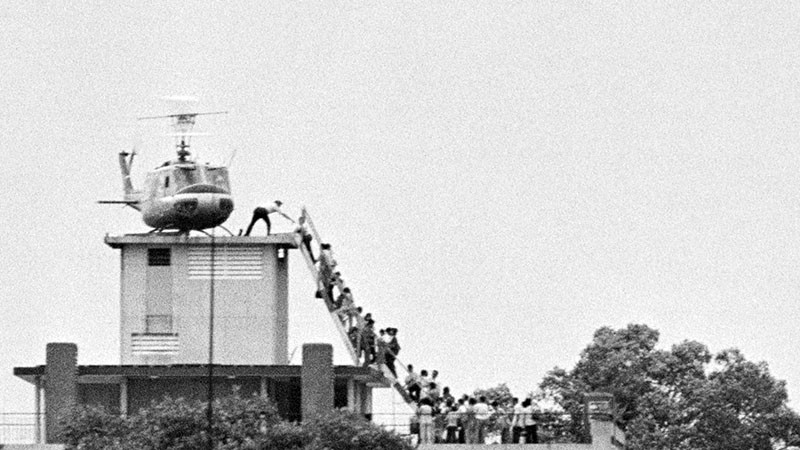More languages
More actions

The Vietnam War (Chiến tranh Việt Nam), also known as the Second Indochina War or the Resistance War against the United States (Kháng chiến chống Mỹ), was a war between the United States, South Vietnam, and their allies and North Vietnam and its allies. It began shortly after the division of Vietnam in 1954 and lasted until the Liberation of Saigon on April 30, 1975.[1] The United States entered the war after the faked Gulf of Tonkin incident.[2] Overall, the war led to three million Vietnamese deaths.[3]
Background
During the Second World War, the Viet Minh led an anti-colonial guerrilla movement against the Japanese occupation of Vietnam.[4]
Japan was defeated in the fall of 1945 and left Indochina. Vietnamese revolutionaries led by Ho Chi Minh declared independence from France and briefly united their country for the first time in modern history.[5] The United States supported France against Vietnam and was providing 80% of its funding by 1953. Vietnamese forces led by Võ Nguyên Giáp defeated France at Điện Biên Phủ in 1954.
The 1954 Geneva Conference partitioned Vietnam into two states and planned to reunify them in 1956 following a national election. The United States created a corrupt, autocratic state in the south led by Ngô Đình Diệm and thwarted plans for reunification.[4]
U.S. invasion
The number of U.S. troops in Vietnam increased from 800 in early 1961 to 3,000 by the end of the year and 11,000 in 1962. They began as military advisers for the South Vietnamese army but later participated in combat operations against guerrillas in the south. After Kennedy's assassination in 1963, Lyndon Johnson escalated the war with bombing raids. He abandoned the guise of military advisers in 1965 and began openly fighting against communist forces.
At the peak of the war in 1969, there were over 540,000 troops in Vietnam in addition to over 100,000 in nearby countries. Soldiers from U.S. satellite states such as Australia, New Zealand, the Philippines, Thailand, and south Korea also participated in the war. The south Vietnamese army also grew to a force of nearly a million by the end of the war. The United States retreated from Vietnam in early 1973 but continued to support the southern government until its defeat in 1975.[4]
U.S. war crimes
From 1967 to 1972, the CIA helped South Vietnam identify and kill suspected communist guerrillas as part of the Phoenix Program, causing at least 26,000 deaths.
In March 1968, US soldiers killed at least 347 unarmed civilians in Sơn Mỹ village.[6] The soldiers who tried to stop the massacre were considered traitors by the other soldiers and U.S. congressmen.[7]
Chemical weapons
The USA, as part of Operation Ranch Hand, used Agent Orange, a chemical weapon, over vast areas of jungle in Vietnam. The government of Vietnam states that 4 million people were exposed to the agent most of whom suffered life long illnesses and some of whom suffered birth defects.
Agent Orange was produced by the Dow Chemical Company and the Monsanto Company, as well as others.
Legacy
In the USA, the Vietnam War was correctly considered a U.S. defeat until Ronald Reagan rebranded it as a "noble cause." Historians continue to deny or ignore U.S. war crimes.[4]
References
- ↑ Charles G. Boyd (1998). The Paris Agreement on Vietnam: Twenty-five Years Later. Washington, DC: The Nixon Center.
- ↑ Andrew Glass (2016-08-07). "Congress approves Gulf of Tonkin Resolution: Aug. 7, 1964" Politico. Retrieved 2022-01-05.
- ↑ Ziad Obermeyer, et al. (2008). Fifty years of violent war deaths from Vietnam to Bosnia: analysis of data from the world health survey programme. British Medical Journal. doi: 10.1136/bmj.a137 [HUB]
- ↑ 4.0 4.1 4.2 4.3 Nick Turse (2013). Kill Anything That Moves: 'Introduction' (pp. 10–13). [PDF] New York City: Metropolitan Books. ISBN 9780805086911 [LG]
- ↑ Howard Zinn (1980). A People's History of the United States: 'The Impossible Victory: Vietnam' (pp. 438–439). [PDF] HarperCollins. ISBN 0060194480
- ↑ Susan Brownmiller (1975). Against Our Will: Men, Women and Rape (pp. 103–05). Simon & Schuster. ISBN 9780671220624
- ↑ Hugh Thompson (2003). Moral Courage In Combat: The My Lai Story. [PDF] Center for the Study of Professional Military Ethics, United States Naval Academy.
